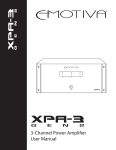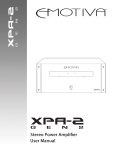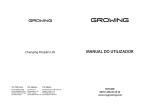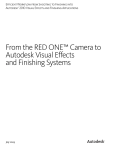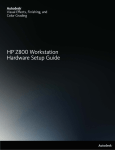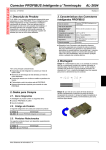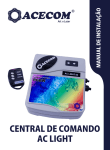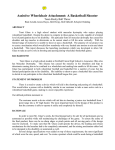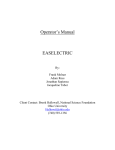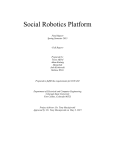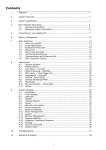Download Team MS Paint User`s Manual
Transcript
Team MS Paint User’s Manual June 1 2010 Team MS Paint spent the 2009-2010 school year designing and manufacturing a paint tube opener for Jan Lipes. Jan is a retired surgeon who lives in Doylestown, Pennsylvania. He was diagnosed with multiple sclerosis and was forced to retire. Having lost the use of his right arm and being confined to a wheel chair, Jan is unable to create sufficient grip and torque to open his oil based paint tubes. Team MS Paint designed a horizontal sitting device which is operational using one hand. This allows Jan to be able to be more self sufficient in his work and no longer rely on others to be able to get his work done. Designing to make a difference for Jan Lipes. BACKGROUND Jan Lipes was a very successful surgeon until he was diagnosed with multiple sclerosis. After this his life was changed, he was forced to retire from his life of medicine. This did not stop Jan from blazing his own path. Jan retook to his love of painting after he was confined to a wheel chair and lost the use of his dominant right hand. He taught himself to paint with his left and has become a very successful Pennsylvania impressionist painter. He has been able to sell his paintings for upwards of three thousand dollars, which has become a source of income in his household. He faced troubles in not being able to be self sufficient in his painting and has sought many methods to keep from becoming dependent on others. The University of Connecticut designed and built Jan a paint tube opener to help him in his journey for independence but this device did not perform up to Jan’s needs. Team MS paint was informed of Jan’s situation through Dr. Hallowell. The team decided this was a project worth pursuing and took on the challenge of trying to design to make a difference in Jan Lipes’ Life. STATEMENT OF PROBLEM The device to be designed and manufactured for Jan needed to be capable of opening paint tubes whether they were brand new or if they had been mostly used. The primary need of the device directly from Jan was that it needed to be able to open partially opened tubes when they had a dried paint seal. This was the primary problem that Jan’s current device had and was something that he always had to ask for help to be able to accomplish. The design also needed to be able to operate with the use of one hand since Jan has limited mobility in his right arm. These things all combined together to create a unique problem which was to be solved. RATIONALE This project was chosen because without a functioning paint tube opener the client is not able to provide for himself. After retiring from his career as a surgeon the client’s new source of income is selling his paintings. In his disabled state he is unable to open paint tubes by himself, relying on the help of others to be able to do his job, which is unacceptable. By making him an opener, we will allow the client to become self-reliant in his profession, allowing him to lead a normal life without being held back by his multiple sclerosis. DESIGN The design of the paint tube opener was based on a self centering vise to hold the paint tube and a small motor to remove the paint tube cap. The design for the cap removal came from an electric screwdriver. The motor from the electric screwdriver was encased in a special motor mount that was designed to hold the electric motor while not needing the old screwdriver housing. The motor mount drawing can be found in the appendix. The motor mount assembly was coupled to the 1 original screwdriver head to utilize the original gearing of the screwdriver. To keep the paint tube stationary during cap removal a self centering vise was designed. A drawing of the self centering vise can be found in the appendix. The self centering vise was designed with a screw that had opposite direction threads on it to cause the vise to move in towards the center. A standard vise could not be used because as different size paint tubes were used the distance from the center of the vise to the edge of the tube would change. The vise and the motor mount were mounted on a 5”x12”x1” aluminum plate. The aluminum plate was used because the extra weight was needed to keep the opener stationary. The aluminum plate also added aesthetic appeal to the opener. An open/closed toggle switch was added and the motor was wired up to the original screwdriver battery and charger. Using the original battery and charger allowed us to use the original wiring setup and not need to design our own wiring schematics. Using the original components also gives us the option to easily replace the battery if it becomes defective. DEVELOPMENT Figure 1: Constructed Paint Tube Opener Prototype Figure 1 depicts the complete constructed prototype. 6061 Aluminum and plastic were selected to build the device for their light weight and strength. The base was milled out to reduce weight as decided by our initial specifications. The base footprint was reduced from the initial size after considerations were taken for the motor and tube vise. The rechargeable battery configuration for the screwdriver motor helps solve the power failure and also adds a portable feature that was previously not considered. The on/off switch has a light on it to indicate when the power is on, also the sound of the motor is a warning as well. The internal gearing that came with the driver was kept since it is a durable design and provides plenty of torque output. In order to grip the cap, it was discovered that basic 12-point sockets do the job with ease. Not only do they tightly grip the cap, but they minimize the wear and thus the likelihood of destroying the caps. Also, different sized paint tubes can be used by simply changing the socket size, making the opener more versatile. The tube holder itself is a vise, made to open well beyond the largest tube the client uses and to close to 2 meet the sizes of the smaller used tubes that he rolls from the bottom. In overall construction of the device, a left-handed theme was kept to cater to Jan’s needs. The base of the opener is coated with rubber to hinder the entire device from sliding around on his work surface. EVALUATION Upon completion of the prototype, it was tested by both the group, to see if it met the initial design specifications, and Jan for client feedback. Table 1: Initial and Final Specification comparison mL Initial Value 37-500 Final Value 37-500 in-lb unknown 3.5 YES ft < 10 < 12x24x36 5 YES 5x12x4.5 YES Metric Units Tube Size Torque Needed Cord Length Device Size in Unscrew Time Set up Time Weight Device Life Success? YES sec < 10 3 YES min lb years <1 < 50 > 10 <1 <10 ? YES YES Table 2 compares the initial specifications, which were established at the beginning of the year, to the final values that were analyzed during prototype testing. It is evident that each of the specs has been met by the completed device. The client’s requirements that were expressed to the group at the start of the project were also addressed. According to Jan the device had to: Open half full tubes, Open 37 mL tubes, be one handed operational, Easy to operate, Low maintenance, and Low strength. After visiting Jan and watching him use the device and express his complete approval it is safe to say that each one of his requirements were met. A quote taken from an email sent by Jan to the group sums up his satisfaction with the opener stating, “The device is ingenious, works perfectly for me and will be a great assist in my work.” DISCUSSION This project met all of its objectives. The client is able to use it with ease and is thoroughly satisfied with it. The paint tube opener can open multiple sized, is very quick and easy to setup, opens the tubes quickly and efficiently and is fully portable with backup rechargeable battery power. We were within all of the original design parameters. While the project is very unique the team does not feel that it is patentable, we did not really design anything new, instead drawing inspiration from multiple already produced items. While there are many people suffering from 3 symptoms and restrictions similar to Jan’s the team feels that there is not a large enough market for this project to be made in mass numbers or marketed to the public. If this project was to be redone it would be better if the drip tray was positioned better and also much cheaper if the vise screw only needed to be made once instead of three times. Other than this we feel that the project is an outstanding success and are all very pleased with the end results achieved. REFERENCES AND ACKNOWLEDGEMENTS Special Thanks to Randy Mulford for his assistance and guidance in the manufacturing process 4 APPENDIX 7.1 FMEA To begin, there were eight possible modes of failure that needed to be addressed in order to guarantee the success of the opener. These modes were then rated using the system provided in the SrD WebBook, by evaluating the severity, occurrence, and detectability. On a scale of 1 – 10 for each characteristic with 10 being the worse case, each mode was rated. Then possible solutions to these failure modes were discussed and used to reevaluate them in an attempt to lower their ratings. The results of this analysis are shown below. Table 2: FMEA for the eight modes of failure Modes of Failure Severity Occurrence Dectecability Totals Motor Torguing out Before After 9 9 6 3 7 5 378 135 Gear Failure Before After 9 9 3.5 2 8 8 252 144 Severity Occurrence Dectecability Totals Motor Failure Before After 9 9 3 2 7 7 189 126 Power Failure Before After 7 5 3 3 7 1 147 15 Gripping Cap Before After 9 9 2.5 1.5 2 2 45 27 Turn Wrong Direction Before After 4 4 2 1 2 1 16 4 Destroying Cap Before After 4 3 3 2 2 2 24 12 Cap Wear Before After 2.5 2 4 4 2 2 20 16 Solutions Motor Torquing Out • • • Simulate dried paint on threads and test torque needed to remove cap Design with a factor of safety of 2-3 Test the prototype on caps that have been stuck on with dried paint Gear Failure 5 • • • Buy a pre-made gearbox Use the gearing from the screwdriver if sufficient Design for much larger torque Gripping Cap • • • Prototype testing Material selection of gripper Grip pressure control Destroying Cap • • Design to the lifetime of the paint of tube being used Ensure sufficient grip strength on the cap Motor Failure • • • Use a new motor Eliminate unnecessary spin cycles Buy a motor with more than required torque Power Failure • • • Power Light indicator Back-up battery Make rechargeable Turn Wrong Direction • • Indicator Light Lock in the correct direction Cap Wear • Ensure proper cap gripping strength Using the solutions listed above, the ratings for all of the eight modes of failure were decreased as seen in Table 1, for the totals of the “before” and “after” columns. It is important to know that, the ratings of 9 do not mean that this is a severe health hazard. Instead, for the sake of this device, they stand for failures that are detrimental to the opener and would render it useless. With these modes of failure on the table and the possible solutions at hand, the experiments were performed to test for critical data. 6 8.0 Design Refinement for Production Provide an overview and some details of the design refinement process you used to go from the prototype design to the final design, including how design methods were applied. 8.1 Final Design Development and Validation In order to improve and optimize the design initially conceptualized, the team created five areas of the project design, and conducted parametric studies to improve these areas. The five studies conducted included one test each to minimize the size and weight of the connector bar, the tube holder and the motor mount, and one test each to find a lightweight, low cost material for the base plate and tube holder. In each case, several geometries, sizes and/or materials were considered and compared, in order to find the most efficient selection. The primary goals were to minimize weight while still withstanding applicable stresses in order to minimize shipping cost, and minimize material costs. 8.1.1 Tube Holder Material Selection Figure 8.1.1: Tube Holder used in this parametric study 7 For the parametric study, a weight versus cost analysis was performed on the tube holder pictured above. The part stands 3.5” tall, 3.0” wide and 6.5” long with the obvious cut outs and holes. Further thin walling would not be necessary considering the amount of material that has been removed already. The main reasons that this topic was chosen for this analysis are because this is being created for a client with use of only one hand. He should be able to move it if need be without straining himself. Also, the unit will be sitting on top of a table, so too much weight could do damage to it. Finally, it doesn’t make practical sense for this part to be heavy or bulky. Its purpose is to hold a paint tube with the help of a V jaw, so it will not be seeing a ridiculous amount of torque or stress. For this study, the variable parameter is the material, while the constant constraint is the part itself. Basically, six different materials were selected for the part and their characteristics were analyzed using Algor and Solid Edge. Then, with the dimensions needed as well as the material type, McMaster-Carr was used to find the cost of the stock needed to make the part. The most difficult part of this study was trying to find the correct sized stock on McMaster-Carr that could be used to manufacture the part. For the purpose of this study, the part was broken up into three parts; the two walls at the full height of 3.5’’ and the center section whose dimensions are 1.5’’ thick, 2’’ wide, and 6.5’’ long. The most important variable in this study is the weight of the part. As a guideline, the part should be less than 5 lb and the cost should be less than $60. These are high values but it provides some leeway in the material selection. The yield strength and modulus of elasticity will be taken into account when making the final decision as well. Table 1 below shows the results from the study in no specific order. Table 8.1.1: Parametric Weight vs. Cost Results Material Density (lb/in³) Al 6061-T6 9.80E-02 1.00E+07 ABS Medium Impact Plastic 3.70E-02 Polypropylene, General Purpose Modulus of Elasticity Yield Strength (psi) (psi) Weight (lb) Total Cost 4.00E+04 3.71 $54.28 3.30E+05 6.30E+03 1.40 $58.69 3.30E-02 1.60E+05 4.80E+03 1.25 $17.21 PVC 5.00E-02 400 1.00E+03 1.89 $39.44 303 Stainless Steel 0.29 2.80E+07 3.70E+04 10.97 $271.86 Unalloyed Titanium 0.16 1.49E+07 2.50E+04 6.17 N/A Titanium First off, the titanium was immediately thrown out of the running since the cost of the stock could not be determined. In order to keep the study fair, McMaster was the only company used to find the material cost, and they did not have the sizes needed to complete the study for titanium. However from experience, the titanium would be very expensive, and way beyond the $60 limit. 8 303 Stainless Steel As with the titanium, the stainless steel was also dropped as a consideration for creating the tube holder. Both the weight and the cost are well over the limits. Having over a 10 lb part amiss an entire assembly adds up quickly especially since the overall dimensions are around 5”x12”x7”. The $271.86 cost was not only over the limit for the part, but also is near our projected final budget. This material, in the end, is highly impractical for this part. 6061-T6 For the aluminum, both the weight and cost are below their respective limits. They are both in the upper area of their limits but they do meet the standards. The yield strength and elasticity are obviously higher than the plastics, which do add some appeal to the material. But, as mentioned earlier, they do not have to be too high since the loads it will experience are not that significant. ABS As with the aluminum, the ABS meets the limits for weight and cost, however the cost is a surprising $58. This is somewhat unappealing for the fact that if the part was to break it would cost quite a bit to get it fixed. Of all the plastics in the study, ABS has the highest yield strength and elasticity, which may outweigh the high cost, in the final decision. Polypropylene This material is well below the established limits. It also possesses the mid level yield strength and elasticity specifications of the plastics. The cost is definitely the most appealing factor for this plastic. Being that it is so cheap, it would make replacing a broken part nicer for the client. But with that cheap price comes the question, is the material quality cheap? PVC Like the other plastics, the PVC is within the weight and cost limits. The price is not too high in the $60 limit, but the interesting factor is the very low yield strength and elasticity. This could lead to the assumption that it is a more brittle or rigid material and won’t have that little flex that is always a plus. Conclusion The purpose of this analysis was to find the lightest, medium strength, material at the lowest price. Based on this requirement, and the idea that the tube holder would be made entirely of one material, the Polypropylene is the best choice. Not only is it lightweight and extremely cheap, but it does have a decent yield strength and modulus of elasticity. Plastic is easy to machine which cuts manufacturing time down as well. On a side note, if strength was a large concern a better route would be a combination of two materials. In that case, an aluminum center piece to house the moving parts would be ideal with Polypropylene walls for weight. This combination would allow for all the best material qualities as well as providing a light and cheap finished part. 8.1.2 Motor Mount Weight Minimization The objective of the parametric study was to test and analyze a part from the senior design project and then redesign the part while optimizing size, weight, material, or some other parameter. For this parametric study, the weight and overall size of the part was reduced, while still maintaining the structural strength needed to operate correctly. ALGOR FEMPRO was used to perform the finite element analysis. 9 The part that was being studied was a motor mount for team MS Paint. The motor mount houses a small DC electric motor that has a max torque output of 20 inch pounds. The motor is originally from a small electric screwdriver and because the motor itself doesn’t supply the amount of torque needed, a gearbox must be used. The gearbox to be used was the one that originally came with the electric screwdriver. The motor mount needed to be designed so that the motor could be used in conjunction with the gearbox. To perform the parametric study, a 3d model of the part was constructed using AutoCAD Inventor. When constructing the part, the gear box was also modeled. The gearbox was not one of the parts that needed to be optimized, but it needed to be in the model to allow the torque to be applied at the end of the shaft. To analyze the part a mesh was created across the part at 0.05” mesh length. The 0.05 mesh length was because that is the smallest mesh that the part would converge at. If any smaller mesh size was used the part would seem to diverge. This could be because the part was putting very small concentrated loads in places where the part was constrained together. To apply the torque load to the part, the equation Torque = 2*Force*radius, was used. This showed that a force of 3.86 lbf needed to be applied to each side to achieve a net torque of 20 inch pounds. This force was applied at the end of the gear box because this is where the gearbox will turn the cap off the paint tube. To achieve the applied torque, a nodal force needed to be applied at both the top and bottom of the shaft. The torque needed to be applied this way because ALGOR has no method of applying the torque directly. When using a nodal force to apply a torque it will create stress concentrations at the point where the load is applied, these stress concentrations need to be hidden because they will yield incorrect results. To hide these stress concentrations the whole gearbox part was hidden. It was acceptable to hide the complete gearbox because the gearbox is a purchased part that is not being studied. The loads were applied to the motor mount assembly as shown in figure 1 below. Figure 8.1.1: Motor mount design When the finite element analysis was performed, brick elements were used with mesh sizes of 0.2”, 0.15”, 0.10”, 0.075” and 0.05”. The final mesh size of 0.05” was used. The material that 10 was used to manufacture the motor mount was Low Density Polyethylene. This material was chosen because it was already available, it’s light, strong, and it is suitable for our needs. Using a mesh length of 0.05” showed the von Mises stress at 3.279 lbf/(in2) for the original motor mount. This stress yielded a minimum safety factor of 487.5. This means that the part is extremely overdesigned and that there is room for thin walling the part and creating cutaways. The results for each of the different mesh sizes on the original motor mount are shown in table 1 below. The von Mises stresses of the original part are shown below in figure 2. Table 8.1.2: Stress vs. mesh size for motor mount Parametric Study of Original Part Mesh Size (in) Tresca*2 Min. Safety Stress lbf/(in^2) von Mises Stress (lbf/(in^2)) Total Nodes DOF Factor 0.2 1.804 1.626 4664 13596 885.6 0.15 1.797 1.668 7350 21372 934.8 0.1 1.985 1.786 16058 46725 886.2 0.075 0.05 2.776 3.685 2.431 3.279 94725 32415 99504 292977 641 487.5 Figure 8.1.3: Modified motor mount design The new modified motor mount was changed by thin walling the top and bottom of the part and removing 0.1” of material. The sides of the mount had cutaways put into both sides. The cutaways on the sides will help with both weight and improve airflow allowing the motor to cool more easily. The modified motor mount also had .1875” of material removed from the end of the 11 mount. An engineering drawing of both the original and the modified motor mount are included in the end of this section. When the finite element analysis was performed on the modified motor mount, a mesh size of 0.05 was again used. The max von mises stress was found to be 3.334 lbf/in2. This gave a minimum factor of safety of 479.32. This factor of safety is still extremely over engineered, but size restrictions and manufacturing methods limit what else can be done to the part. In table 2 below the tresca and von Mises stresses are all shown for the various mesh sizes on the modified part. Figure 3 below shows the von Mises stresses for the modified part. Table 8.1.3: Stress vs. mesh size for new motor mount design Parametric Study of Modified Part Mesh Size (in) Tresca*2 Stress (lbf/(in^2)) von Mises Stress (lbf/(in^2)) Total Nodes DOF Min. Safety Factor 0.2 2.922 2.735 3419 1146 742.8 0.15 2.453 2.377 6330 18447 673 0.1 0.075 0.05 2.716 3.113 3.453 2.716 3.006 3.334 46002 15673 29644 87270 94330 279372 548.1 531.5 479.32 Figure 8.1.4: Final motor mount design The weight saving of the modified part to the original part was 1.071oz. This is a small amount of weight savings, but about 28% weight reduction. Another benefit to the design of the modified part is that it allows airflow to the motor keeping it cool. Cooling the motor is not a major concern because it will not run for extended periods of time; however it is an added benefit to the new design. The max von Mises stress for the new part was 3.334 lbf/in2, this value was only 5% 12 larger of a stress than the original part. The part is far within the limits of it breaking or permanently deforming and has a safety factor of 479.32. The part could be made smaller, but there is not a lot of room to remove much more material. If the screws weren’t in there and the motor pins weren’t there it would be much easier to remove more material and the mount could be made much smaller. 8.1.3 Tube Holder Weight Minimization For my parametric study I am finding the lightest material possible to make the sidewalls of the tube clamp, pictured below, out of while being as affordable as possible. Each component of the opener has to be maximized in weight because we will be shipping this opener back and forth between our client Jan and ourselves and cannot afford to ship an opener that weighs too much. Figure 8.1.5: Tube holder assembly To figure this relationship out I used Algor to determine how much the sidewalls weighed being made out of different materials, then I went to mastercraft.com and found the cost of the materials. The sidewalls need to be made out of metal or plastic for easy cleaning and to allow for easy machining in the lab. The cost of machining is not factored into the costs of material because we will be doing all the machining ourselves and will not be paying ourselves. The table below shows a list of possible materials, the materials weight and the cost. Table 8.1.3: Material weight and cost Material Weight (lbs) Cost ($) Aluminum 6061 3.86 57.71 Aluminum 2024 3.98 81.44 PVC 1.87 26.64 Stainless Steel 303 11.32 290.12 Stainless Steel 309 11.44 54.16 Titanium 6.44 223.09 13 It is easier to compare the different materials in the two graphs below than in the table. The first graph shows the weight of the sidewalls if they were made from each material. Figure 8.1.6: Weight of Sidewalls of Each Material The second graph shows the cost of the sidewalls if they were made from each material. Figure 8.1.7: Cost of Sidewalls of Each Material The graphs show that the most obvious choice for the sidewalls of the tube clamp mechanism is PVC plastic because it is at half the weight and cost of the closest competitor, Aluminum 6061. This allowed us to decide to use PVC for the sidewalls of the tube clamp rather easily. 8.1.4 Weight Minimization of Connector Bar The purpose of the parametric study is to find the minimum size, and thus weight, of the connector piece which connects the motor to the collet cap gripper mechanism I designed. The connector is 14 essentially two protrusions back-to-back, one is square shaped to connect to the motor, and the other is hexagonal shaped to connect to the collet. The square side’s geometry is dictated by the motor connection – 0.25 inches a side, 0.075 inch depth – and thus remains constant, while the hexagonal size is what will be varied according to the results of the study. The goal is to have a geometry and size which can withstand the worst case scenario of loading without exceeding the material yield strength, while using the least amount of material to do so. The worst case scenario is would be the motor outputting the maximum amount of torque, 15.12 in*lb as found by our 488 lab, while encountering complete resistance and not being able to turn at all. The material to be used for this piece is AISI 1010 steel, which has a yield strength of 305 MPa. Note that no factor of safety is being used, because we found in another 488 experiment that the tube will twist and be destroyed at a torque well below the maximum the motor can produce, and thus that naturally adds a factor of safety of about 2.5. In order to simulate this scenario, the torque was converted to an edge force to be applied to each edge of the square side of the connector. Thus, 15.12 in*lb, with a perpendicular distance of 0.125 in from the axis of rotation yields a force of 120.96 lb. Since the force will be applied along each of the four edges, it was then divided by four to get 30.24 lb applied to each side. The length of the hexagonal piece is 0.25 in, and for the initial test, I held the outer 0.125 in fixed. The reason for this is as follows: call the length of the body of the paint tube the x-direction. The cap is removed by spinning about this axis, and thus the collet and connector piece also spin about this axis. However, the collet is free to traverse along the connector, and so the whole length of the connector will not always be inside the collet, but instead only a portion. Thus another parameter, in addition to the size of the connector, is the length which is to be kept inside of the collet. The results of the first few trials showed that even with a sufficiently large geometry, the stress was too high, and thus the amount of overlap had to be increased. For the next set of trials, I set the overlap to 0.175 in, and while the results were more acceptable, the stress was still too high as the mesh was refined. Finally, by using an overlap length of 0.200 in, and a hexagonal edge length of 0.150 in, the results converged to an acceptable stress. All of this is summarized in the table below, and the diagram shows what is meant by the sizes labeled “a” and “b” in the table. Table 8.1.4: Stress vs. mesh and part size for connector bar Size Mesh a (in) b (in) (in) 0.100 0.100 0.125 0.125 0.135 0.135 0.200 0.01 0.200 0.005 0.250 0.01 0.250 0.005 0.270 0.01 0.270 0.005 0.135 0.270 0.01 0.135 0.270 0.005 0.150 0.300 0.01 Parametric Results Elements Stress (#) (psi) (MPa) 0.125 in constrained 1460 30944 213.35 6218 44225 304.92 1669 36447 251.29 6964 41901 288.90 1753 29871 205.95 7283 41315 284.86 0.175 in constrained 1753 29923 206.31 7283 37138 256.06 1907 31746 218.88 Displacement (in) 0.000132 0.000135 0.000127 0.00013 0.000123 0.000126 0.000123 0.000126 0.000116 15 0.150 0.300 0.005 0.150 0.300 0.01 0.150 0.300 0.005 0.150 0.300 0.003 7904 37454 258.24 0.200 in constrained 1907 28455 196.19 7904 37651 259.59 21800 39420 271.79 0.000119 0.000116 0.000119 0.00012 Figure 8.1.8: Connector bar dimensions 8.1.5 Base Plate Material Selection For my parametric study I determined the mass versus the cost of different materials that could be used to make the base plate of our paint tube opening devices. To do this study the part which is shown below (Figure 1) was placed into ALGOR and Solid Edge ST2 to determine the mass based on it being constructed from different materials. This study looked for a balance between the weight as well as the cost. The purpose of this study is to find the material that will have a low cost but also have a medium weight. The base itself needs to have some weight to hold itself down as it is being operated the target is to find a material that will weigh between five to seven pounds. This allows for our customer Jan Lipes to be able to operate it with one hand using the base plate as a counter to the forces that he will be applying to the device. The stresses that are going to be applied to this base are minimal and negligible therefore has no effect on the material choice. 16 Figure 8.1.9: Base plate design Table 1 below shows the mass as well as the prices for the materials to be purchased to manufacture the base plate. The prices below show what the cost would be to purchase the raw material before it would be manufactured. In the case of this project the machine time does not cost us any actual money value so that time was not calculated into the cost analysis. If machining costs were to be included in our budget that would change many of the values but all would be increased based upon their machinability. Table 8.1.5: Mass and Cost of Materials 17 The data is shown in a much more visual manner in the graphs below. Figure 1 shows the cost of each material as well as the mass of each material. This allows a much easier representation of how the materials compare to each other in each category. A cherry would base would be the cheapest material to create our device out of. Figure 3 shows the masses of the materials comparative to each other. Figure 8.1.10: Cost of base plate materials Figure 8.1.11: Mass of base plate materials We can see from Figure 3 that the four makes of Aluminum fit in the mass range that was targeted. We then refer back to Figure 2 to find which of these four materials has the lowest cost. This tells us 18 that Aluminum 6061 has the lowest cost of the four materials in the targeted mass range. This allows for our selection of the material Aluminum 6061 to be used to manufacture our base plate. 13 19 Section 9.2 Manufacturing Costs The paint tube opener was designed with the plan of only manufacturing one device. The cost report was created with the idea that only one paint tube opener was going to be created. In Table 9.1.1 below, a breakdown of total time, labor/overhead cost, material cost and total cost can be seen. To determine these costs, the operation to create each sub assembly was analyzed. We then determined the amount of time that was necessary to perform each operation. Based on the technical difficulty of the task, operation labor and overhead costs were added to the cost. Table 9.1.1 Manufacturing Cost and Time Sub Assembly Motor Mount Vise Baseplate Riser Block and Battery Cover Screwdriver Motor and Hardware Whole Assembly Total Time 6.35 9.8 4.5 9 Labor/Overhead Material Cost Cost 230 20 443 45 235 45 311.25 15 Total Cost 304 488 280 326.25 1 12 65 77 30.65 1231.25 190 1421.25 The most expensive part of the paint tube opener to create was the vise. The vise was the most expensive because it had the most material in it and it had a large amount of machining involved in it. In order to reduce some of the costs of manufacturing the vise, the vise was designed with the minimal amount of work needed to create it. The mounting block on the ends and both of the moving jaws on the vise were both made from ½’ x 1’ aluminum square stock. This eased production because the bar only then needed to be cut to length, drilled and tapped. Since we used this method for the lower bars on the vise, upper paddles needed to be constructed for the jaws. This method allowed us to use different materials on the jaws and to save money by only having one size of material to buy for the lower jaws. Another way that we saved money was by utilizing the parts from an electric screwdriver. The gearbox, driver, electric motor, and battery were all used from the electric screwdriver. A different motor mount housing was created to mount the motor in because there was no need to have the complete old screwdriver housing mounted on the paint tube opener. The device was powered using the battery from the original screwdriver. This eliminated the need to find a different power supply and deal with extra wiring. Using the parts from this electric screwdriver saved a 20 large amount of time because of the various design and manufacturing that had already been done to create the screwdriver. Design for Manufacturability If the paint tube opener was going to be manufactured on a large scale, there are some things that would be designed differently. The first major change would be to make the base plate out of a type of plastic that could be injection molded. The injection molding would cut down on a large amount of manufacturing time because there would be virtually no machining to do. The base plate could also be molded directly onto the riser plate eliminating the need for another part. The motor mount is already made of plastic and could be easily molded eliminating more machining time. Adhesives could be used to secure the various parts together rather than bolts. A different design of a self-centering clamping mechanism would also facilitate a quicker and easier manufacturing process. 21 OHIO UNIVERSITY Team MS Paint User’s Manual Designing to make a difference for Jan Lipes. 22 Introduction: This device was made by the Ohio University Senior Design Team, Team MS Paint. It was created for the artist named Jan Lipes. Jan Lipes is a retired surgeon who lives in Bucks County, Pennsylvania. He was forced into retirement after being diagnosed with Multiple Scyrosis, eventually losing the used of his dominant right hand and being confined to a wheel chair. He taught himself how to paint with his left hand and is now pursuing a successful career as an oil painter. This opener was designed to be operated with only one hand so that Jan could independently open his paint tubes and pursue his career without assistance. Warnings: • • • Pinch points – be aware of fingers when tightening or loosing vise Rotating parts – be sure all loose clothing can fingers are away from motor shaft when using Electric shock – do not use in or around water, risk of electric shock, electrocution and/or death Directions: Note: This device can be operated while plugged in or while running on battery power 1) Be sure that vise is sufficiently open for your paint tube 23 2) Find the proper socket assembly size: a. b. c. d. 3) Blue – 5/8” Red – 18 mm Black – 14.5 mm Green – 14 mm Place socket assembly into motor attachment 24 4) 5) Place paint tube cap in socket, allowing socket to hold tube up Tighten vise allowing a snug enough contact with paint tube to prevent rotation 25 6) 7) Flip the rocker switch powering on the motor After 2-5 seconds flip rocker switch again to power off the motor 26 8) 9) Release the paint tube from device Place paint needed on palate 27 10) 11) Tighten vise 2-5 turns Slide paint tube into vise vertically, with threads on top 28 12) 13) Pull socket assembly from motor opening Use socket assembly to screw cap back on paint tube 29 14) 15) Loosen vise Remove paint tube 30 Suggested Maintenance Schedule and Instructions: • • • Be sure to recharge the battery after every couple of weeks of use or if the motor struggles opening paint tubes. Wipe excess paint out of sockets If battery no longer holds a charge it can be replaced , see “Replace Battery” and “Replacement Parts Information” sections Replace Battery: 1. 2. 3. 4. Unscrew battery cover Disconnect slide attachment points of wires on battery Reconnect wires to new battery Replace cover and screws Troubleshooting and Service Instructions: • • If socket slips without opening tube, try smaller socket If opener doesn’t run when switch is activated check plug or try plugging into the wall Replacement Parts Information • Replacement battery: DeWALT 497755-01 31
































